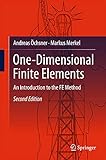One-Dimensional Finite Elements [electronic resource] : An Introduction to the FE Method / by Andreas Öchsner, Markus Merkel.
By: Öchsner, Andreas [author.] .
.
Contributor(s): Merkel, Markus [author.] | SpringerLink (Online service)
| SpringerLink (Online service) .
.
Material type:  BookPublisher: Cham : Springer International Publishing : Imprint: Springer, 2018Edition: 2nd ed. 2018.Description: XXIII, 418 p. online resource.Content type: text Media type: computer Carrier type: online resourceISBN: 9783319751450.Subject(s): Mechanics, Applied
BookPublisher: Cham : Springer International Publishing : Imprint: Springer, 2018Edition: 2nd ed. 2018.Description: XXIII, 418 p. online resource.Content type: text Media type: computer Carrier type: online resourceISBN: 9783319751450.Subject(s): Mechanics, AppliedMotivation for the Finite Element Method -- Bar Element -- Torsion bar -- Bending Element -- General 1D Element -- Plane and Spatial Frame Structures -- Beam with Shear Contribution -- Beams of Composite Materials -- Nonlinear Elasticity -- Plasticity -- Stability (Buckling) -- Dynamics -- Special Elements.
This textbook presents finite element methods using exclusively one-dimensional elements. It presents the complex methodology in an easily understandable but mathematically correct fashion. The approach of one-dimensional elements enables the reader to focus on the understanding of the principles of basic and advanced mechanical problems. The reader will easily understand the assumptions and limitations of mechanical modeling as well as the underlying physics without struggling with complex mathematics. Although the description is easy, it remains scientifically correct. The approach using only one-dimensional elements covers not only standard problems but allows also for advanced topics such as plasticity or the mechanics of composite materials. Many examples illustrate the concepts and problems at the end of every chapter help to familiarize with the topics. Each chapter also includes a few exercise problems, with short answers provided at the end of the book. The second edition appears with a complete revision of all figures. It also presents a complete new chapter special elements and added the thermal conduction into the analysis of rod elements. The principle of virtual work has also been introduced for the derivation of the finite-element principal equation.


There are no comments for this item.